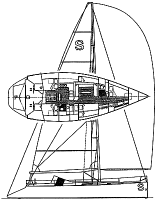Stockgroup 14-meter
Racer-cruiserr
The line between racers and cruisers can get blurred. Don't wait for me to spell out the differences. All I can come up with is something that involves interiors and ease of handling, which are very difficult to quantify. There are as many valid, different approaches to cruising boats as there are types of cruising sailors.
This design appears to be equally suited to racing as it is to cruising. The 14-meter is 4 inches shorter than the Andrews 50, but it is 2 feet, 10 inches beamier. I like narrow boats. But the broad beam of the 14-meter makes it perfect for water ballast. This design uses 2,200 pounds of water ballast per side. That's the equivalent of 10 of me sitting on the rail. Beam at the waterline is narrow for light-air speed. I know water ballast works and works especially well on really beamy boats, but I still prefer the simplicity and safety of nonwater-ballasted cruising boats. "Put your back into that pump dear, we're catching them." The D/L of this design is 88.96.
This 46-footer has a big interior despite its low displacement. The galley appears roomy but shows a cooking range with no oven, which is unusual for a cruising boat. Note the dinette settee. I think the seats are too narrow as drawn. This is a small thing, but imagine trying to sit back and relax after a meal on a shallow seat. The proper minimum dimension from the face of the seat back (without cushion) to the front of the seat is 27 inches. Tiny details like this make an interior fit and feel right. These dimensional details are as critical to a cruising boat as genoa track locations are on a racing boat.
The rig of this design features a near-masthead rig with a big main and relatively small foretriangle. The spreaders are strongly swept aft. The SA/D is 29.28. I think we could argue well into the night about the suitability of such a high SA/D on a cruising boat.
The clients that come to me for custom cruising boats between 45 and 60 feet usually plan on cruising with a crew of two, i.e. husband and wife. The style of sailing that most of these couples develop is to motor in light air when boat speed drops below 4 knots. Today's long cruising boats should be motoring comfortably at 8.5 knots or better. It's not purist sailing, but if we admit to ourselves that we don't enjoy drifting along at speeds less than half of hull speed, then why place such a premium on light-air speed when it just means that you will have to reef sooner?
My own boat has a disgustingly low SA/D but I have never reefed it, never. I don't enjoy drifting along at 3 knots if I am trying to make harbor by nightfall, so I motor in light air. Cruisers seldom anticipate the reef in time, so it's always a thrash. I prefer a cruising boat that will stand up to its rig, and I just can't see any cruising boat with a SA/D over 27 (being generous) doing that, even with water ballast. Once again, this is one particular sailing style issue and is entirely subjective.
This is an unusual boat and I suppose I have indicated clearly that I don't agree with all of the features. Having said that, I will say that I find the photos to show a very aggressive- and sexy-looking hybrid racer-cruiser. You can analyze, calculate and compare ratios, but only actually taking the wheel will reveal the entire personality of any boat. Some boats seem to have awkward design relationships but under sail they come together beautifully and display a wonderful, complimentary, balanced synergy of characteristics. It's my estimate that the Stockgroup 14-meter is just that sort of boat.

Comments